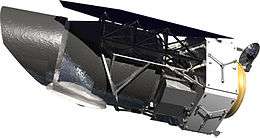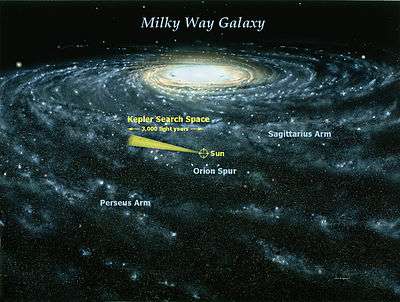Wide Field Infrared Survey Telescope
 Rendered model of the WFIRST spacecraft | |
| Names | Joint Dark Energy Mission |
|---|---|
| Mission type | Infrared Space observatory |
| Operator | NASA / JPL / GSFC |
| Website |
wfirst |
| Mission duration | 6 years (planned)[1] |
| Spacecraft properties | |
| Launch mass | 4,166 kg (9,184 lb)[2] |
| Dry mass | 4,059 kg (8,949 lb)[2] |
| Payload mass | 2,191 kg (4,830 lb)[2] |
| Power | 2500 watts |
| Start of mission | |
| Launch date | Mid-2020s |
| Rocket | Delta IV Heavy (proposed)[2] |
| Contractor | United Launch Alliance (proposed) |
| Orbital parameters | |
| Reference system | Sun–Earth L2 |
| Regime | Halo orbit |
| Periapsis | 188,420 km (117,080 mi) |
| Apoapsis | 806,756 km (501,295 mi) |
| Main telescope | |
| Type | Three-mirror anastigmat |
| Diameter | 2.4 m (7 ft 10 in) |
| Wavelengths | Near-infrared, visible light |
| Transponders | |
| Band |
S band (TT&C support) Ka band (data acquisition) |
| Bandwidth |
Few kbit/s duplex (S band) 290 Mbit/s (Ka band) |
| Instruments | |
|
Coronagraph Instrument Wide Field Instrument | |
The Wide Field Infrared Survey Telescope (WFIRST) is a future infrared space observatory that was recommended in 2010 by United States National Research Council Decadal Survey committee as the top priority for the next decade of astronomy. On February 17, 2016, WFIRST was formally designated as a mission by NASA.[3]
WFIRST is based on an existing 2.4m wide field-of-view telescope and will carry two scientific instruments. The Wide-Field Instrument is a 288-megapixel multi-band near-infrared camera, providing a sharpness of images comparable to that achieved by the Hubble Space Telescope over 100 times the area. The Coronagraphic Instrument is a high contrast small field of view camera and spectrometer covering visible and near-infrared wavelengths using novel starlight-suppression technology.
The design of WFIRST is based on one of the proposed designs for the Joint Dark Energy Mission between NASA and DOE. WFIRST adds some extra capabilities to the original JDEM proposal, including a search for extra-solar planets using gravitational microlensing.[4] In its present incarnation (2015),[5] a large fraction of its primary mission will be focused on probing the expansion history of the Universe and the growth of cosmic structure with multiple methods in overlapping redshift ranges, with the goal of precisely measuring the effects of dark energy,[6] the consistency of General Relativity, and the curvature of spacetime.
Overview
The original design of WFIRST (Design Reference Mission 1), studied in 2011–2012, featured a 1.3 m (4 ft 3 in) diameter unobstructed three-mirror anastigmat telescope.[7] It contained a single instrument, a visible to near-infrared imager/slitless prism spectrometer. In 2012, another possibility emerged: NASA could use a second-hand National Reconnaissance Office telescope made by Harris Corporation to accomplish a mission like the one planned for WFIRST. NRO offered to donate two telescopes, the same size as the Hubble Space Telescope but with a shorter focal length and hence a wider field of view.[8] This provided important political momentum to the project, even though the telescope represents only a modest fraction of the cost of the mission and the boundary conditions from the NRO design may push the total cost over that of a fresh design. This mission concept, called WFIRST-AFTA (Astrophysics Focused Telescope Assets), was matured by a scientific and technical team;[9] this mission is now the only present NASA plan for the use of the NRO telescopes.[10] The WFIRST baseline design includes a coronagraph to enable the direct imaging of exoplanets.[11]
WFIRST has had a number of different implementations studied (including the Joint Dark Energy Mission-Omega configuration, an Interim Design Reference Mission featuring a 1.3m telescope,[12] Design Reference Mission 1[13] with a 1.3m telescope, Design Reference Mission 2,[14] with a 1.1m telescope, and several iterations of the AFTA 2.4m configuration). In the most recent report,[5] WFIRST was considered for both geosynchronous and L2 orbits. Appendix C documents the disadvantage of L2 vs. geosynchronous in the data rate and propellant, but the advantages for improved observing constraints, better thermal stability, and more benign radiation environment at L2. Some science cases (such as exoplanet microlensing parallax) are improved at L2, and the possibility of robotic servicing at either of the locations requires further study.
The project is led by a team at NASA's Goddard Space Flight Center in Greenbelt, Maryland. The Project Scientist for WFIRST is Neil Gehrels; the Project Manager is Kevin Grady; the Program Scientist is Dominic Benford; the Program Executive is John Gagosian; the Formulation Science Working Group is chaired by Gehrels with Deputy Chairs David Spergel and Jeremy Kasdin.[15]
Science objectives
The science objectives of WFIRST aim to address cutting edge questions in cosmology and exoplanet research, including:
- Answer basic questions about dark energy, complementary to the ESA EUCLID mission, and include: Is cosmic acceleration caused by a new energy component or by the breakdown of general relativity on cosmological scales? If the cause is a new energy component, is its energy density constant in space and time, or has it evolved over the history of the universe? WFIRST will use three independent techniques to probe dark energy:
- Baryon acoustic oscillations
- Observing distant supernovae
- Weak gravitational lensing
- Complete a census of exoplanets to help answer new questions about the potential for life in the universe: How common are solar systems like our own? What kinds of planets exist in the cold, outer regions of planetary systems? – What determines the habitability of Earth-like worlds? This census makes use of a technique that can find exoplanets down to a mass only a few times that of the Moon:
- Establish a guest investigator mode enabling survey investigations to answer diverse questions about our galaxy and the universe.
- Provide a coronagraph for exoplanet direct imaging that will provide the first direct images and spectra of planets around our nearest neighbors similar to our own giant planets.
WFIRST will have two instruments. The Wide-Field Instrument (WFI) is a 288-megapixel camera with a 0.28 square degree field of view providing multi-band near-infrared (0.7 to 2.0 micron) imaging using a HgCdTe focal-plane array with a pixel size of 110 milliarcseconds. It includes a grism for wide-field slitless spectroscopy and an integral field spectrograph for small-field spectroscopy. The second instrument is a high contrast coronagraph covering shorter wavelengths (0.4 to 1.0 micrometers) using novel starlight-suppression technology. It is intended to achieve a part-per-billion suppression of starlight to enable the detection of planets only 0.1 arcseconds away from their host stars.
Status

In fiscal year 2014, Congress provided $56 million for WFIRST, and in 2015 Congress provided $50 million.[16] The fiscal year 2016 spending bill provided $90 million for WFIRST, far above NASA's request of $14 million, allowing the mission to enter the "formulation phase" in February 2016.[16] On February 18, 2016, NASA announced that WFIRST had formally become a project (as opposed to a study), meaning that the agency intends to carry out the mission as baselined;[3] at that time, the "AFTA" portion of the name was dropped as only that approach is being pursued. WFIRST is on a plan for a mid-2020s launch. The total cost of WFIRST is expected at more than $2 billion;[17] NASA's latest estimate is around $2.0 billion in 2010 dollars, which corresponds to around $2.7 billion in real year (inflation-adjusted) dollars.[18]
See also
References
- ↑ "WFIRST Observatory". NASA Goddard Space Flight Center. 25 April 2014. Retrieved 2015-06-10.
- 1 2 3 4 "WFIRST-AFTA Science Definition Team Final Report" (PDF). NASA Goddard Space Flight Center. 13 February 2015. Retrieved 2015-06-10.
- 1 2 "NASA Introduces New, Wider Set of Eyes on the Universe" (Press release). 2016-02-18. Retrieved 2016-02-18.
- ↑ National Research Council (2010). New Worlds, New Horizons in Astronomy and Astrophysics. Washington, D.C.: National Research Council. ISBN 0-309-15802-8. Retrieved 27 January 2011.
- 1 2 "WFIRST Science Definition Team 2015 Report" (PDF). 2015-03-10. Retrieved 2016-02-23.
- ↑ WFIRST Wide-Field Infrared Telescope Home Page, http://wfirst.gsfc.nasa.gov/about/
- ↑ WFIRST Science Definition Team Final Report, 2012-08-15, arXiv:1208.4012

- ↑ "Ex-Spy Telescope May Become a Space Investigator - NYTimes.com". 2012-06-04. Retrieved 2012-06-10.
- ↑ WFIRST-AFTA SDT Final Report, revision 1 (PDF), 2013-05-23, retrieved 2013-09-10
- ↑ Dan Leone (2013-06-04). "Only NASA Astrophysics Remains in Running for Donated NRO Telescope — For Now; SpaceNews article". Retrieved 2017-07-17.
- ↑ NASA (2014-04-30). "WFIRST Science Definition Team Interim Report" (PDF). Retrieved 2014-08-28.
- ↑ Green & Schechter (2011-07-11). "WFIRST IDRM" (PDF). Retrieved 2016-02-23.
- ↑ "WFIRST DRM1" (PDF). 2012-05-17. Retrieved 2016-02-23.
- ↑ Green & Schechter (2012-08-15). "WFIRST DRM2". arXiv:1208.4012
 .
. - ↑ Sullivan, John (2016-02-18). "Princeton professors to lead NASA science team probing universe and planets" (Press release). Princeton. Retrieved 2016-02-18.
- 1 2 Foust, Jeff (7 January 2016). "NASA's Next Major Space Telescope Project Officially Starts in February". Space.com. Retrieved 2016-01-09.
- ↑ Daniel Clery (2016-02-19). "NASA moves ahead with its next space telescope". Science Magazine. Retrieved 2016-02-20.
- ↑ "NASA Astrophysics: Progress toward New Worlds, New Horizons, page 44" (PDF). NRC. 2015-10-08. Retrieved 2016-02-23.
External links
| Wikimedia Commons has media related to Wide Field Infrared Survey Telescope. |
- WFIRST page at Goddard Space Flight Center site
- WFIRST Science Data Center page at the Infrared Processing and Analysis Center (IPAC)
- "Astro2010 Report Release Presentation".
- $1.6 Billion Telescope Would Search Alien Planets and Probe Dark Energy — Space.com
- The WFIRST/AFTA astrophysics mission: bigger and better for exoplanets, Tom Greene
- NASA/ Goddard – WFIRST: Uncovering the Mysteries of the Universe on YouTube (min. 1:25) May 30, 2014
- WFIRST-AFTA: Coronograph Technology Development on YouTube (min. 4:20) Mar 16, 2015
- WFIRST: The Best of Both Worlds on YouTube (min. 3:14) Feb 18, 2016


